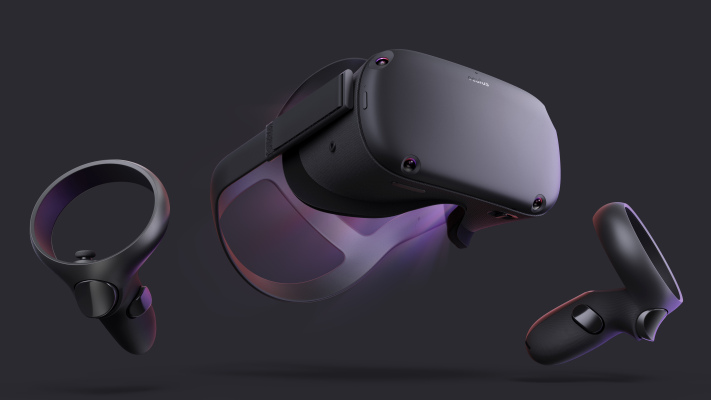TECHNOLOGY
5 Trends Of Augmented Reality In Communication

Technology has been rapidly changing over the last couple of years, with many innovations introduced into our digital world. While some of them were not so significant, there were a few ones that proved to be successful.
One of the technologies which facilitated those changes is Augmented Reality which had a significant effect on many industries including retail, gaming and entertainment.
AR has also influenced the area of digital communication which was especially notable at the beginning of the pandemic when many of us had to start doing our usual working, learning and other activities from home.
Like any emerging technology, AR’s speed of innovation and growth is fast and it can be a real challenge for companies and their customers to keep track of the trends of Augmented Reality in communication. Some of them presented in this article will continue to define the digital communication industry in 2021. They are the ones your company will need to pay attention to.
Augmented Reality In Communication: 5 Interesting Trends For 2021
1. Remote Video Collaboration Using Virtual Backgrounds & Face Filters [/H3]
Due to the ongoing global pandemic, doing many daily activities on a remote basis became a new normal. The CEOs of the major tech companies in the U.S. including Google, Amazon and Microsoft have even allowed their employees to work from home, either indefinitely or until the end of 2020. People got used to working, learning and socializing remotely over video conferencing apps because they needed to adhere to social distancing rules being set in many countries across the globe.
Many technological companies including Zoom, Google and Microsoft have in response introduced their conferencing apps which enjoyed their biggest popularity ever in March of 2020, when they topped 62 million downloads during the week of March 14-21.
Data Source: appannie.com
Even though working and studying remotely proved to be doable and effective, many individuals did not feel confident about their physical appearance and the world surrounding them as proved by the results of the research from Cloud and Managed Services provider Maintel. Moreover, many of us started to suffer from so-called “Zoom fatigue” while being on call for long periods of time.
Virtual backgrounds implemented in popular video conferencing apps proved to be a solution because these tools allow meeting participants to make their video conferences more interactive, enjoyable and comfortable while keeping personal privacy at the higher level.
Another useful feature for conducting video calls is face touch up. The technology can refine a person’s appearance in front of the camera in different ways, including skin smoothing, teeth whitening, improved camera lightning and much more. As shown by the results of the study prepared for one of the conference on computer supported cooperative work and social computing, looking good in front of the camera can make people feel better about themselves and give more confidence.

2. The Rise Of AR-Powered E-Learning Platforms
This sector saw a boom because of the rising demand for e-learning solutions powered by AR technology among students and teachers.
Online learning platforms and virtual classrooms are now helping various groups of people to learn new things distantly during the pandemic. With the help of technological advancements, teachers can attach AR experiences to objects of curiosity such as 3D life-size models, from where students can learn about the object via hovering a phone or tablet over it.
Making a studying process fun for students is no longer a tedious process. Teachers can download an AR-powered educational app and use it to explain concepts in the most creative way possible using face filters, AR masks and virtual backgrounds.
With many Internet users willing to work and learn from home even after the pandemic and the continuous advancements in AR, we can expect a further rise of the e-learning platforms with the respective market size set to reach $375 billion by 2026, growing at an 8% CAGR.
3. The Increased Popularity Of AR-Powered Short Video Content
With the pandemic and much of the world sheltering in place, we’ve seen an explosion of short, entertaining videos on Instagram Reels, Tiktok, Snapchat Spotlight and Triller.
People have started to use short videos to share their daily updates with friends and relatives. To make their videos more engaging, they often take advantage of video editing software to augment their video content with AR features such as lenses, virtual background and face filters.
Businesses such as Walmart have turned to short video content because they can use this medium to demonstrate the latest products to the potential customers and let them be tried online using virtual try-on technology.
With the uncertain future of Tiktok in both the U.S. and India as well as the continuous interest of e-commerce companies in promoting their products using video content, we can expect the trend to continue in 2021, with more and more tech companies set to introduce their alternatives to TikTok in the near future.
Do you want to enhance your own short mobile video app with Face AR technology? Get to know our mobile video editor SDK. It includes the best collection of filters, animated backgrounds and AR overlay features.
4. The Use Of AR For Virtual Try Ons In Live Streaming
The live streaming technology enjoyed one of its strongest popularity in 2020. With major industry events forced to go virtual due to the pandemic, businesses had to get creative. Many of them took advantage of live streaming AR to communicate with their customers about the latest products they have to offer.
Why has live streaming become so popular? First of all, the virtual event is much more personal and public-facing than the offline one. Second, participants can join from anywhere across the world, without being at one particular physical location. Third, presenters can take advantage of virtual try-on technology to let users try a particular product in real-time.
The positive effects of AR technology for live streaming events can be demonstrated by the cosmetic company Estee Lauder which used livestream shopping and virtual try ons technology to increase their digital sales by up to 60% amid the pandemic.
The Rise of AR Avatars For Live Streaming
With the people’s increased demand for more personal privacy and the willingness to make online communication more personalized and unique, there is also a growing demand for AR avatars.
In Japan, there are now over 4000 virtual YouTubers. Rather than facing the camera themselves, these people prefer to use a digital version of themselves in the form of an avatar.
The users of the Twitch online streaming platform can take advantage of a virtual makeover with Snap’s AR effects that give them a way to be creative while doing live streams of their favourite games and other content.
Conclusion
With the constant change of the world we all live in, there is no doubt that the use of Augmented Reality in communication will set new technological trends both businesses and users will need to adapt to.
Nowadays, AR technology is not only limited to Snapchat’s funny filters and Pokemon Go. The software can be found in almost every area of our world, be it education, work, healthcare or entertainment. The extent to which businesses can adapt it for their advantage will influence their competitive advantage and the effectiveness of building long-lasting customer relationships.
TECHNOLOGY
Next-gen chips, Amazon Q, and speedy S3

AWS re:Invent, which has been taking place from November 27 and runs to December 1, has had its usual plethora of announcements: a total of 21 at time of print.
Perhaps not surprisingly, given the huge potential impact of generative AI – ChatGPT officially turns one year old today – a lot of focus has been on the AI side for AWS’ announcements, including a major partnership inked with NVIDIA across infrastructure, software, and services.
Yet there has been plenty more announced at the Las Vegas jamboree besides. Here, CloudTech rounds up the best of the rest:
Next-generation chips
This was the other major AI-focused announcement at re:Invent: the launch of two new chips, AWS Graviton4 and AWS Trainium2, for training and running AI and machine learning (ML) models, among other customer workloads. Graviton4 shapes up against its predecessor with 30% better compute performance, 50% more cores and 75% more memory bandwidth, while Trainium2 delivers up to four times faster training than before and will be able to be deployed in EC2 UltraClusters of up to 100,000 chips.
The EC2 UltraClusters are designed to ‘deliver the highest performance, most energy efficient AI model training infrastructure in the cloud’, as AWS puts it. With it, customers will be able to train large language models in ‘a fraction of the time’, as well as double energy efficiency.
As ever, AWS offers customers who are already utilising these tools. Databricks, Epic and SAP are among the companies cited as using the new AWS-designed chips.
Zero-ETL integrations
AWS announced new Amazon Aurora PostgreSQL, Amazon DynamoDB, and Amazon Relational Database Services (Amazon RDS) for MySQL integrations with Amazon Redshift, AWS’ cloud data warehouse. The zero-ETL integrations – eliminating the need to build ETL (extract, transform, load) data pipelines – make it easier to connect and analyse transactional data across various relational and non-relational databases in Amazon Redshift.
A simple example of how zero-ETL functions can be seen is in a hypothetical company which stores transactional data – time of transaction, items bought, where the transaction occurred – in a relational database, but use another analytics tool to analyse data in a non-relational database. To connect it all up, companies would previously have to construct ETL data pipelines which are a time and money sink.
The latest integrations “build on AWS’s zero-ETL foundation… so customers can quickly and easily connect all of their data, no matter where it lives,” the company said.
Amazon S3 Express One Zone
AWS announced the general availability of Amazon S3 Express One Zone, a new storage class purpose-built for customers’ most frequently-accessed data. Data access speed is up to 10 times faster and request costs up to 50% lower than standard S3. Companies can also opt to collocate their Amazon S3 Express One Zone data in the same availability zone as their compute resources.
Companies and partners who are using Amazon S3 Express One Zone include ChaosSearch, Cloudera, and Pinterest.
Amazon Q
A new product, and an interesting pivot, again with generative AI at its core. Amazon Q was announced as a ‘new type of generative AI-powered assistant’ which can be tailored to a customer’s business. “Customers can get fast, relevant answers to pressing questions, generate content, and take actions – all informed by a customer’s information repositories, code, and enterprise systems,” AWS added. The service also can assist companies building on AWS, as well as companies using AWS applications for business intelligence, contact centres, and supply chain management.
Customers cited as early adopters include Accenture, BMW and Wunderkind.
Want to learn more about cybersecurity and the cloud from industry leaders? Check out Cyber Security & Cloud Expo taking place in Amsterdam, California, and London. Explore other upcoming enterprise technology events and webinars powered by TechForge here.
TECHNOLOGY
HCLTech and Cisco create collaborative hybrid workplaces

Digital comms specialist Cisco and global tech firm HCLTech have teamed up to launch Meeting-Rooms-as-a-Service (MRaaS).
Available on a subscription model, this solution modernises legacy meeting rooms and enables users to join meetings from any meeting solution provider using Webex devices.
The MRaaS solution helps enterprises simplify the design, implementation and maintenance of integrated meeting rooms, enabling seamless collaboration for their globally distributed hybrid workforces.
Rakshit Ghura, senior VP and Global head of digital workplace services, HCLTech, said: “MRaaS combines our consulting and managed services expertise with Cisco’s proficiency in Webex devices to change the way employees conceptualise, organise and interact in a collaborative environment for a modern hybrid work model.
“The common vision of our partnership is to elevate the collaboration experience at work and drive productivity through modern meeting rooms.”
Alexandra Zagury, VP of partner managed and as-a-Service Sales at Cisco, said: “Our partnership with HCLTech helps our clients transform their offices through cost-effective managed services that support the ongoing evolution of workspaces.
“As we reimagine the modern office, we are making it easier to support collaboration and productivity among workers, whether they are in the office or elsewhere.”
Cisco’s Webex collaboration devices harness the power of artificial intelligence to offer intuitive, seamless collaboration experiences, enabling meeting rooms with smart features such as meeting zones, intelligent people framing, optimised attendee audio and background noise removal, among others.
Want to learn more about cybersecurity and the cloud from industry leaders? Check out Cyber Security & Cloud Expo taking place in Amsterdam, California, and London. Explore other upcoming enterprise technology events and webinars powered by TechForge here.
TECHNOLOGY
Canonical releases low-touch private cloud MicroCloud

Canonical has announced the general availability of MicroCloud, a low-touch, open source cloud solution. MicroCloud is part of Canonical’s growing cloud infrastructure portfolio.
It is purpose-built for scalable clusters and edge deployments for all types of enterprises. It is designed with simplicity, security and automation in mind, minimising the time and effort to both deploy and maintain it. Conveniently, enterprise support for MicroCloud is offered as part of Canonical’s Ubuntu Pro subscription, with several support tiers available, and priced per node.
MicroClouds are optimised for repeatable and reliable remote deployments. A single command initiates the orchestration and clustering of various components with minimal involvement by the user, resulting in a fully functional cloud within minutes. This simplified deployment process significantly reduces the barrier to entry, putting a production-grade cloud at everyone’s fingertips.
Juan Manuel Ventura, head of architectures & technologies at Spindox, said: “Cloud computing is not only about technology, it’s the beating heart of any modern industrial transformation, driving agility and innovation. Our mission is to provide our customers with the most effective ways to innovate and bring value; having a complexity-free cloud infrastructure is one important piece of that puzzle. With MicroCloud, the focus shifts away from struggling with cloud operations to solving real business challenges” says
In addition to seamless deployment, MicroCloud prioritises security and ease of maintenance. All MicroCloud components are built with strict confinement for increased security, with over-the-air transactional updates that preserve data and roll back on errors automatically. Upgrades to newer versions are handled automatically and without downtime, with the mechanisms to hold or schedule them as needed.
With this approach, MicroCloud caters to both on-premise clouds but also edge deployments at remote locations, allowing organisations to use the same infrastructure primitives and services wherever they are needed. It is suitable for business-in-branch office locations or industrial use inside a factory, as well as distributed locations where the focus is on replicability and unattended operations.
Cedric Gegout, VP of product at Canonical, said: “As data becomes more distributed, the infrastructure has to follow. Cloud computing is now distributed, spanning across data centres, far and near edge computing appliances. MicroCloud is our answer to that.
“By packaging known infrastructure primitives in a portable and unattended way, we are delivering a simpler, more prescriptive cloud experience that makes zero-ops a reality for many Industries.“
MicroCloud’s lightweight architecture makes it usable on both commodity and high-end hardware, with several ways to further reduce its footprint depending on your workload needs. In addition to the standard Ubuntu Server or Desktop, MicroClouds can be run on Ubuntu Core – a lightweight OS optimised for the edge. With Ubuntu Core, MicroClouds are a perfect solution for far-edge locations with limited computing capabilities. Users can choose to run their workloads using Kubernetes or via system containers. System containers based on LXD behave similarly to traditional VMs but consume fewer resources while providing bare-metal performance.
Coupled with Canonical’s Ubuntu Pro + Support subscription, MicroCloud users can benefit from an enterprise-grade open source cloud solution that is fully supported and with better economics. An Ubuntu Pro subscription offers security maintenance for the broadest collection of open-source software available from a single vendor today. It covers over 30k packages with a consistent security maintenance commitment, and additional features such as kernel livepatch, systems management at scale, certified compliance and hardening profiles enabling easy adoption for enterprises. With per-node pricing and no hidden fees, customers can rest assured that their environment is secure and supported without the expensive price tag typically associated with cloud solutions.
Want to learn more about cybersecurity and the cloud from industry leaders? Check out Cyber Security & Cloud Expo taking place in Amsterdam, California, and London. Explore other upcoming enterprise technology events and webinars powered by TechForge here.
-

 MARKETING6 days ago
MARKETING6 days agoRoundel Media Studio: What to Expect From Target’s New Self-Service Platform
-

 SEO6 days ago
SEO6 days agoGoogle Limits News Links In California Over Proposed ‘Link Tax’ Law
-
SEARCHENGINES6 days ago
Daily Search Forum Recap: April 12, 2024
-

 SEO5 days ago
SEO5 days ago10 Paid Search & PPC Planning Best Practices
-

 SEARCHENGINES5 days ago
SEARCHENGINES5 days agoGoogle Core Update Volatility, Helpful Content Update Gone, Dangerous Google Search Results & Google Ads Confusion
-

 SEO7 days ago
SEO7 days agoGoogle Unplugs “Notes on Search” Experiment
-

 MARKETING6 days ago
MARKETING6 days ago2 Ways to Take Back the Power in Your Business: Part 2
-

 PPC6 days ago
PPC6 days agoCritical Display Error in Brand Safety Metrics On Twitter/X Corrected








